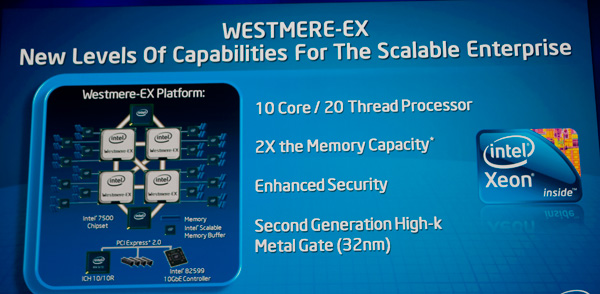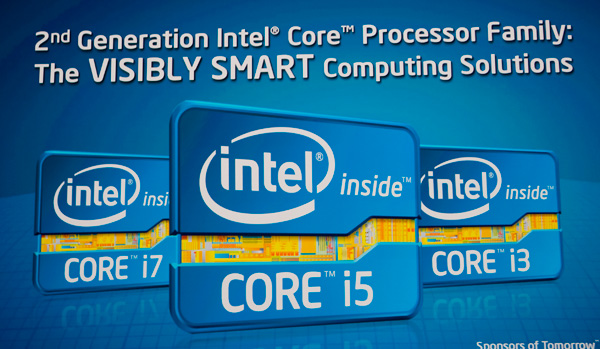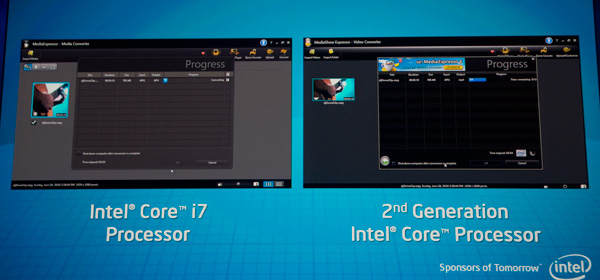Intel Demos Sandy Bridge, Shows off Video Transcode Engine
by Anand Lal Shimpi on September 13, 2010 1:30 PM EST- Posted in
- Trade Shows
- CPUs
- Intel
- Sandy Bridge
Today marks the first day of our IDF 2010 coverage and we just left Dadi Perlmutter's keynote. Keeping up with tradition, Dadi's keynote focused on two of Intel's upcoming microprocessors.
Dadi began his architecture talk with a reference to Westmere EX. The follow-on to Nehalem EX brings the architecture down to a 32nm manufacturing process. The transistor shrink enables Intel to increase core count from 8 on Nehalem EX to 10 on Westmere EX (20 threads).

Westmere EX is socket compatible with current Nehalem EX systems. Along with AES-NI support, Westmere EX also enables support for 32GB DIMMs. Bringing total system memory support from 1TB (64 DIMM slots) to 2TB with Westmere EX.
Sandy Bridge Details
We’re going to hear a lot about Sandy Bridge today. We saw the performance of Sandy Bridge a few weeks ago, but today we’ll find out why it performed the way it did.

Earlier in the keynote, we heard that Ivy Bridge is making its way through the fabs now with production scheduled for 2H 2011
Dadi mentioned that Sandy Bridge has around a billion transistors and that in 10 - 11 years we’ll have chips with 100 billion transistors.
Sandy Bridge brings Intel’s integrated graphics on die as we’ve already mentioned. Now both the GPU and CPU can share the L3 cache, which Dadi indicated resulted in a 4 - 5x increase in GPU performance for data in the cache.

Dadi confirmed that Sandy Bridge would use a high bandwidth ring bus to connect the CPU, GPU and other on-die components to one another.
We also got confirmation that Sandy Bridge will support both CPU and GPU turbo modes.
Officially Sandy Bridge will be called the 2nd generation Intel Core processor, and here are the new logos:

Intel confirmed that Sandy Bridge has dedicated video transcode hardware that it demoed during the keynote. The demo used Cyberlink’s Media Espresso to convert a ~1 minute long 30Mbps 1080p HD video clip to an iPhone compatible format. On Sandy Bridge the conversion finished in a matter of a few seconds (< 10 seconds by my watch).

Dedicated hardware video transcode is Intel’s way of fending off the advance of GPU compute into the consumer market, particularly necessary since you can’t do any compute on Intel’s HD graphics (even on Sandy Bridge).
Given Intel’s close relationship with the software vendors, I suspect we’ll see a lot of software support for this engine when Sandy Bridge ships early next year.
More on Sandy Bridge to follow later today, stay tuned!










18 Comments
View All Comments
Mr Perfect - Monday, September 13, 2010 - link
Am I the only one who immediately translates SB to be south bridge instead of Sandy Bridge? It makes for some really weird comments. They should rename Ivy Bridge to some sort of N___ Bridge in it and really confuse things.Iketh - Monday, September 13, 2010 - link
No you're not the only one, and it's getting increasingly annoying... i lol'd at your N___ Bridge comment thovlado08 - Monday, September 13, 2010 - link
Anand, is 23,976 fps play back finally working? Can you ask please?SteelCity1981 - Monday, September 13, 2010 - link
I've been reading mix things about the compatibility of Sandy Bridge in regards to it being compatible with existing Core i series 1156 sockets. Some say it will be compatible while others say it will not. Any word to confirm rather or not Sandy Bridge will be compatible with current Core i series LGA 1156 sockets?Roland00 - Monday, September 13, 2010 - link
Sandy bridge will use 1155 socket for mainstream and 2011 sock for the high end. Now even though 1155 socket will have 1 less pin it will not be compatible with 1156 due to how the pins are arranged, Intel has a completely different orientation of how these pins will be used (for power, bandwidth, etc) and thus they require new sockets.mschira - Monday, September 13, 2010 - link
Intel had to add a dedicated video transcoding bit to their CPUs. With AMD adding GPU like units to their "APU" versions of CPUs, AMD will most likely be able to accelerate video transcoding, too. They better be, 'cause video transcoding is probably the only high performace task the average person is loading on their computer.Cheers
M.
loadwick - Monday, October 11, 2010 - link
Is that still accuate? That just seems crazy. Intel are going to release a whole new generation in Sandy Bridge and then replace it within 6 months? I just don't see this happening.katleo123 - Tuesday, February 1, 2011 - link
Sandy bridge uses fixed function processing to produce better graphics using the same power consumption as Core i series.
For more info visit http://www.techreign.com/2010/12/intels-sandy-brid...